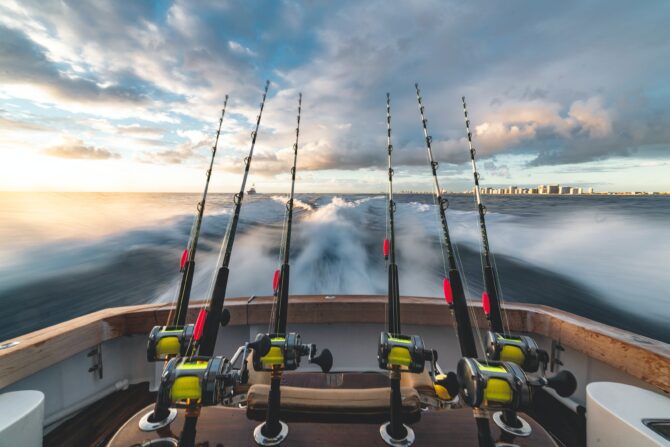Hey there! Ready to dive into the world of jig fishing? Whether you’re looking to spice up your fishing game or just starting out, jig fishing for beginners is a thrilling way to get serious results the next time you hit the water. This guide will walk you through the basics and arm you with some cool tips to get you jigging like a pro in no time.
What Is Jig Fishing?
First off, let’s tackle the basics: what is jig fishing? Fundamentally, jig fishing is a technique that uses a unique kind of lure called a jig. This is no ordinary hook—instead, it’s a weighted head that is sunk into a hook and frequently has a soft body attached to it to make it look more realistic. There are various types of jigs, including the bucktail jig, which features a lead head and hair-like material, and vertical jigs, which are designed for saltwater jigging and come in a range of weights. The unique quality of jig fishing is its capacity to produce abrupt, vertical motions beneath the surface, which closely resemble the actions of distressed or injured baitfish.
Why is this relevant? The fish’s predatory instincts are triggered by these unusual and unpredictable jig motions, leading them to believe that a simple meal is imminent. It’s a powerful technique that taps into the primal feeding behaviours of game fish, making jigs absolutely irresistible to species like bass, walleye, and snapper. Plus, the versatility of jig fishing shines through its suitability for diverse environments—whether you’re angling in the murky depths of freshwater lakes or the expansive, salty seas.
Choose the Right Jig Weight
Selecting the ideal jig can dramatically enhance your jig fishing experience. It is crucial to match the jig weight to the depth and conditions, considering factors such as the species being targeted, water conditions, and fishing techniques. When choosing a jig, consider the water conditions and your target fish species. Heavier jigs excel in deep or turbulent waters, making them suitable for jig fishing for beginners in challenging environments. In contrast, lighter jigs are perfect for shallow or calm waters, where more subtle movements are necessary. Additionally, using live fishing bait is an option to create the look of an injured baitfish that a game fish would want to bite. Colour also matters: opt for hues that mimic local prey in murky waters or natural tones in clear conditions. By mastering the art of selecting the right jig, you’ll improve your chances of a successful catch, making use of these essential jig fishing tips.
Master Jig Fishing Techniques
The core of jig fishing hinges on mastering the right technique. Begin by casting your line and allowing the jig hook to sink to the bottom. This initial positioning is crucial, as it sets the stage for the effective mimicry of a baitfish’s natural movements. Once your jig touches down, the real action begins.
With a firm snap of your wrist, quickly raise the rod tip. This rapid movement propels the jig upwards, mimicking the erratic, darting escape of prey. Angler constantly jig to mimic the movement of an injured baitfish. After the lift, pause briefly to let the jig flutter and spiral back down toward the bottom. This ‘yo-yo’ motion is what makes jig fishing so effective—it perfectly simulates an easy meal, tapping into the predatory instincts of fish. The tempo of your lifts and the length of the pauses can greatly influence your success. Jig fishing techniques create the look of an injured baitfish, making it irresistible to predators. Jig fishing for beginners often involves experimenting with these variables to discover what triggers the best response from local fish. Each body of water and fish species might react differently, so adaptability is key.
Experiment with Retrieval Speeds to Attract Fish
The retrieval speed of your jig is a critical factor that can dramatically influence your success in jig fishing. Initially, it’s advisable to start with a slow, methodical retrieval. This allows the jig to mimic the natural movements of aquatic creatures more closely, which can be particularly effective in cooler or clearer waters where fish are more cautious. High speed jigging, involving quick up-and-down motions to imitate a wounded bait fish, is particularly effective for targeting hard-fighting fish in saltwater, especially those that lurk further from shore.
But conditions for fishing vary, so what works one day might not work the next. Because of this diversity, experimenting with various retrieval speeds is essential. It could be time to make a change if you find that a slow retrieve isn’t drawing any bites. To give the jig more urgency and intensity, gradually accelerate your retrieve speed. This can be particularly alluring in warmer seas or when pursuing ferocious animals. Another technique to experiment with is slow pitch jigging, which targets big bottom-dwelling fish in saltwater and various species in freshwater, including during wintertime for Walleye fishing.
Use the Right Gear and Rod Tip

Investing in a high-quality rod and reel is not just about durability; it’s about enhancing your control and responsiveness when jigging. A medium-heavy rod paired with a fast-action tip is typically recommended. This combination offers the stiffness needed to handle larger, more aggressive fish while maintaining enough sensitivity to detect even the slightest nibbles.
The choice of your reel should complement your rod. For jig fishing, a spinning reel is recommended due to its control and sensitivity to feel the bites. Look for a reel with a smooth, reliable drag system and sufficient line capacity. This is especially important when you’re targeting big fish that might make long, powerful runs. A well-balanced reel will help you manage these challenging situations more effectively, providing the control required to maintain pressure on the fish without risking your line or gear.
Pay Attention to Conditions
Weather and water conditions can affect how fish respond to your jig. Fishing in areas with structure can attract fish, as these areas provide shelter and feeding opportunities. Overcast skies often lead to more aggressive feeding, making it a prime time to try out these jig fishing tips. Always be mindful of the water clarity and temperature as well, adapting your techniques as needed. In addition to the sky conditions, always be observant of the water clarity and temperature. Murky waters might require you to use jigs with brighter colours or more vibration to get noticed, while clear waters typically call for a subtler approach, perhaps with smaller, more naturally coloured jigs.
Temperature also plays a significant role in fish activity levels. Colder water can slow down fish metabolism, meaning your jigging technique should be slower and more deliberate to match the reduced activity of the fish. Conversely, in warmer waters, fish are more active and might respond better to a faster, more aggressive jigging strategy.
The Takeaway
Ready to hit the water? Jig fishing is an exciting way to up your fishing game and enjoy some great catches. And remember, the best way to learn is by doing, so get out there and start jigging!
Not sure where to start or need some local insights? Book a trip with us at Charter Fish Narooma and let’s have a blast fishing together! Sponsored by Daiwa Fishing Tackle Australia, our charters provide you with access to the newest and most advanced fishing rods, reels, and technology available. With our two specially designed boats and local skippers who boast over 30 years of experience fishing the waters of Narooma, we proudly hold the highest catch rate on the south coast.




